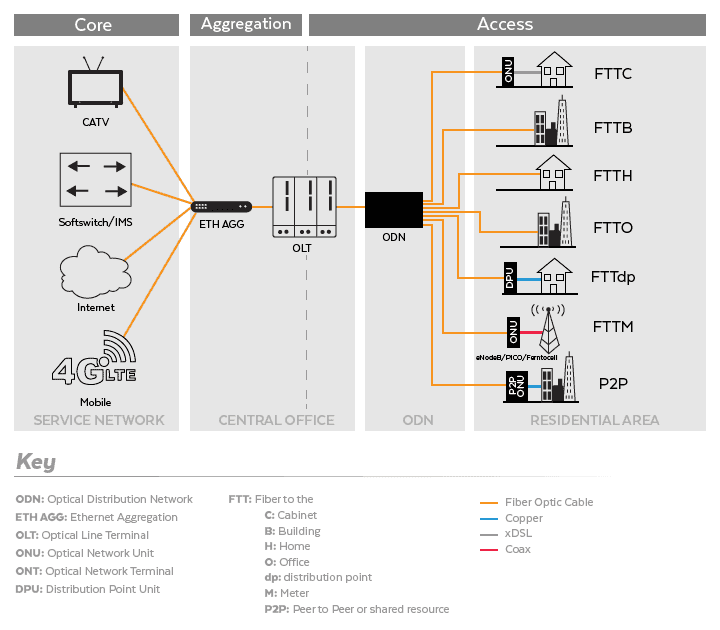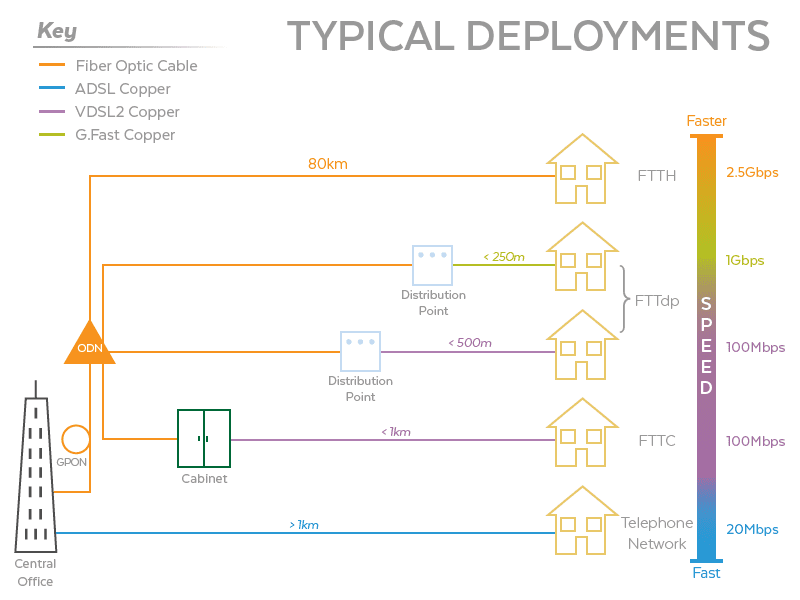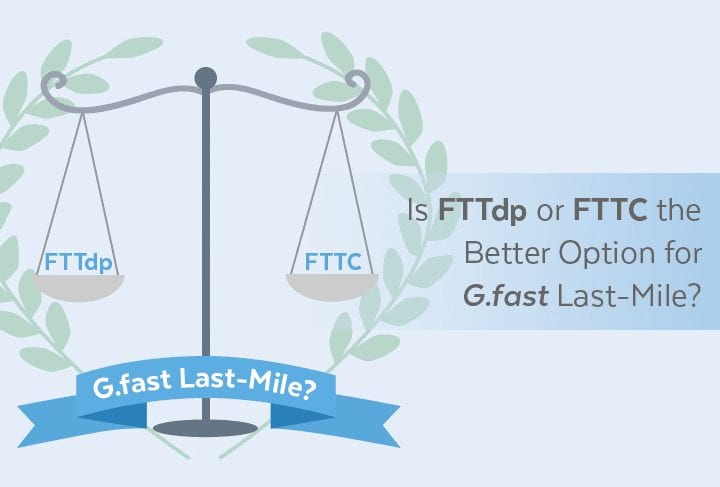For ISPs prioritizing infrastructure upgrade spend, Ultra-fast G.fast broadband technology [300-500 Mbps] over existing copper is a dream come true.
Just as a refresher, G.fast takes advantage of last mile configurations–provider to node to customer–to make this possible. But copper, as may installers know, has its limitations.
For starters, it relies on very short lengths of 100m, making the term “last mile” a bit of an exaggeration. What we’re really talking about is the last 16th of a mile.
With that in mind, US installers may be interested in the forthcoming BT1/Openreach2 G.fast rollout in the UK.
Tensions are running high as customers in rural areas without high-speed broadband and those in the furthest reaches of last-mile proximity to cabinets or distribution points, voice their concerns over needing yet another upgrade for minimal improvement.
There also appears to be a controversy among some circles over that very same last mile configuration. Should Openreach, the subsidiary handling the upgrade, limit itself to the Fiber-To-The-distribution-point (FTTdp) model for the rollout? Or should they instead opt for the Fiber-To-The-Cabinet (FTTC) model which has fewer geo-installation barriers, and will result in a broader and more inclusive outcome?
In this article, we’ll discuss some pros and cons of each solution and allow you, the installer, to draw your own conclusions.
That being said, though installers and ISP technicians may have professional preferences, the “best” solution will often depend on the location where the technology is employed.

The Fiber-To-The-distribution-point (FTTdp) Model
FTTdp is short for Fiber To The Distribution Point. It is actually very similar to FTTC (Fiber to the Curb) or FTTN (Fiber to the Node), but is simply one-junction closer to customers’ premises.
This box is known as the “distribution point” and it allows for near-gigabit speeds.
In FTTdp deployments, a limited number of subscribers at a distance of up to 200-300m are linked to 1 fiber node, which acts as a DSL access multiplexer (DSLAM).
- 328 feet = 100 meters
- 656 feet = 200 meters
- 984 feet = 300 meters
Installers can set up G.fast FTTdp fiber nodes outdoors (on a pole or underground) or indoors (in the basement or on the floor). In fiber-to-the-basement (FTTB) deployments, in-building telephone cabling is often used. Since little needs to be changed, it’s a time saving choice. Each fiber node thus serves a single residence.
The FTTdp approach runs high capacity fiber-optic from the exchange all the way to the node. That node may also be installed in a protected place inside of a public building or business.
The argument in the Openreach installation is that not all FTTdp nodes will be built new. Many are actually existing centralized locations that already have power supplied. One advantage to this approach is a reduction in the amount of remaining copper. This will improve speeds and also maintain a higher signal quality. That in turn means customers will get ultra-high broadband service faster.
But FTTdp boxes may not work everywhere. Rural settings in particular may be problematic.
Other dissenting voices contend that the cost of extending fiber optics and the additional time needed to install it will drive up rates. Still others complain that sharing lines may result in weak signals and crosstalk, and that deadline pressures may lead to overstuffed FTTdp boxes and bundles that diminishing quality in exchange for quantity.
In a 2016 report by https://www.thinkbroadband.com/news/7447-update-on-g-fast-and-lr-vdsl2-trials-from-openreach Thinkbroadband, G.fast pods are predicted to only support 96 lines. Further, at the outset they’ll only support half that number until the necessary anti-crosstalk technologies have evolved.
The benefits of FTTdp in a nutshell
- Robust capability with VDSL (~ 250 Mbps)
- Simple to upgrade to G.fast and FTTP
- Good for growth in the commercial installer trade

The Fiber-To-The-Cabinet FTTC Model
The FTTC solution is already in place in many areas in the UK. One major benefit these cabinets afford is the fact that they can house up to 300 lines. In one sense, this means they could actually serve as a preliminary step for future FTTdp rollouts.
Since the FTTC solution provides a larger percentage of copper than FTTdp, it also uses less of the higher-costing fiber-optic cable. It appears to be the option that will cost consumers less.
But the big question is this: are cabinets close enough to residences in the US to meet the demands of G.fast? In short, some are and some aren’t.
Using those that are as junction points to get closer to homes may be an easy option for a US rollout. Installers in the UK are placing shoebox sized FTTdp units right next to close cabinets and killing the proverbial 2 birds with one stone by maintaining shortened copper lengths that allow G.fast speeds.
Benefits of FTTC
- Uses existing infrastructure
- Less expensive than FTTdp
- Faster delivery of service
Another reason the pure fiber-optic FTTdp solution may be more expensive is that extending it may require digging up the roads and the sides of the streets to lay the cables. But some people feel FTTC is on the way out because of download speed limitations, which may not keep up with customer demands for larger, more sophisticated files like the VR files gamers use.
Final Thoughts
While UK customers watching their full-scale G.fast/BT rollout closely and voicing their concerns in daily papers and IT forums, US installers can watch and learn. The good news is that they’re ironing out some the bugs and highlighting workarounds before a full scale launch occurs here.
G.fast is decidedly green. It both conserves copper and makes a strong case for better quality at affordable rates. As you can see, it’s a close race. Deciding whether to opt for FTTdp or FTTC is ultimately up to you the installer.

